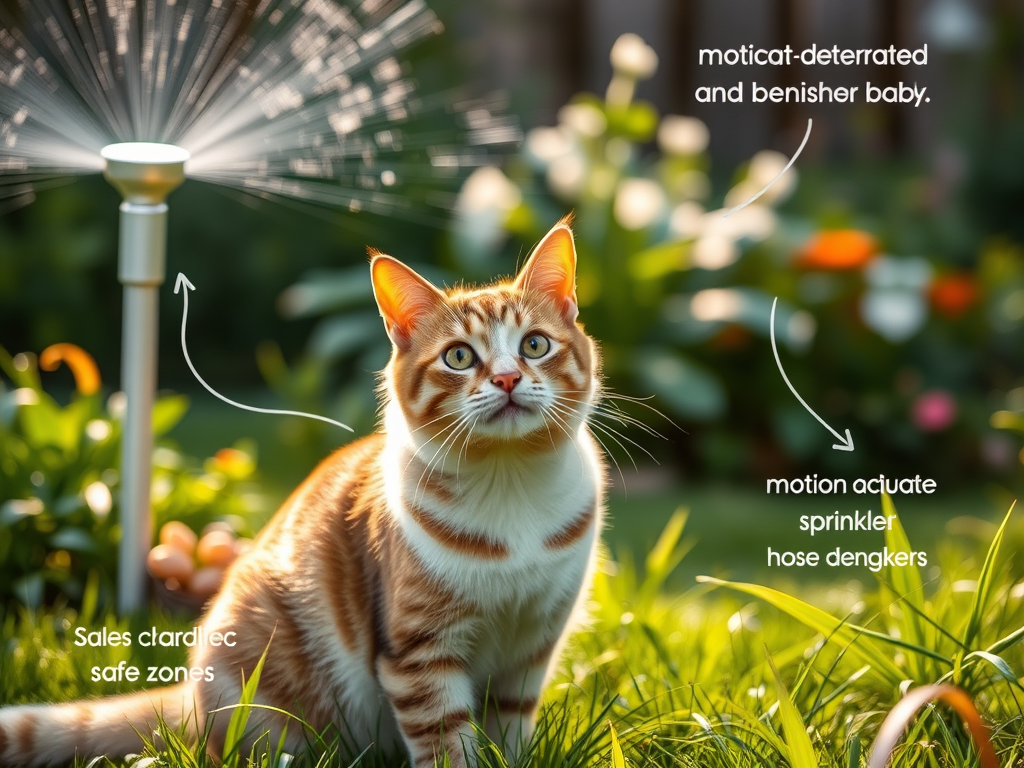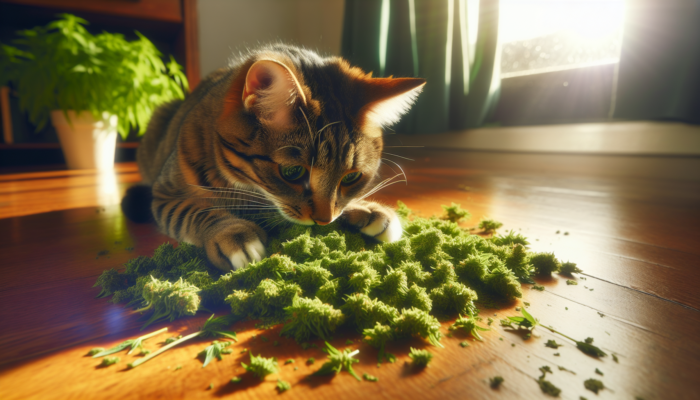Minimize Your Cat’s Hunting Impact
Lessen the Effects of Your Cat’s Hunting
Minimize Your Cat’s Hunting Impact: Cats are natural-born hunters, but keeping them safe indoors can be done without killing their hunting vibe. Crafting an environment that triggers their instincts while keeping them off unsuspecting wildlife is possible.
Interactive toys work wonders for engaging that hunting spirit. Think feather wands, laser pointers, and motorized mice that can keep them hooked for hours. Like how wild cats have to track and pounce, these toys get your cat’s mental gears turning—and maybe even help them burn off some energy, too!
Obstacle courses inside the house? Oh, you bet! Creating a mini-jungle gym with boxes, tunnels, and shelves can transform your living room into a feline adventure land. Cats love to explore all kinds of spaces and heights—they’ll be prowling your DIY safari like lions.
Puzzles aren’t just for humans. Get your paws on some treat-dispensing puzzle feeders. Not only do these keep their brains sharp, but they also mimic the effort they’d naturally put into catching prey. It’s a win-win: mental exercise for them and entertainment for you.
Social interaction is gold. Remember, playing with your cat isn’t just child’s play—it’s a genuine way to bond and reduce their frustration. Schedule some playtime that involves chasing the same toys you grab during solo play.
Keeping an indoor cat happy and instinctually satisfied without unsupervised outdoor access is doable with creativity and effort. More than just decor, your home can become an adventurous landscape that channels its inner hunter without the downsides of outdoor dangers.

Leash Training and Supervised Outdoor Time
Getting your cat used to leash training opens a new world of safe adventures. While dogs are the usual suspects for walks, cats can join the club with patience and practice.
Start easy with a snug-fitting harness. Avoid skipping the introduction phase; let your cat sniff and inspect it first. When they seem comfortable, try putting it on, but don’t rush the process. Slow and steady wins the race here.
Once the harness is no big deal, attach a lightweight leash. Begin indoors where your cat feels secure. This lets them get used to the sensation and gain confidence with every step. Expect a few standoffs, and that’s okay.
Heading outside? Choose a quiet, safe space. Your backyard or a secured area in a park works excellently. Make sure there’s minimal car traffic or dogs around. The outdoor world is full of unknowns, so start with brief sessions to avoid overwhelming your kitty.
Supervised outdoor time lets them enjoy nature without becoming the neighbourhood’s top predator. They enjoy all the sniffs, sights, and sounds without affecting local wildlife. Plus, it’s a bonding experience unlike any other. Just imagine the look of discovery on your little explorer’s face!
Real stories from other cat owners can be inspiring. Many felt unsure or doubted their cat’s willingness to take walks, but with consistency, it’s transformed their cat’s world. It’s about patience and using every success, no matter how small, as a step forward.
With leash training, you ensure their safety and enrich their life experiences. It’s about unlocking a balance between enjoying the great outdoors and keeping it safe for the wildlife that calls it home.
Secure Outdoor Enclosures for Feline Explora
Outdoor cat enclosures, or catios, are the ultimate compromise for adventurous kitties craving a taste of the wild without the danger. These secure spaces allow cats to explore while keeping them out of trouble.
Building or buying a catio doesn’t have to be a massive project. From simple balcony setups to elaborate backyard extensions, there are options to fit every space and budget. What matters is ensuring that it’s escape-proof—it’s all about safety first.
A top design tip? Incorporate different levels and hiding spots. Just like in the wild, cats relish the chance to climb or retreat into cosy corners. Platforms, ramps, and hammocks can turn a simple enclosure into a feline paradise.
Think about sensory enrichment. Plant some cat grass or add logs for scratching and sniffing. Various textures and scents make the experience more engaging, and a few potted plants can give a touch of nature’s tranquillity.
When it comes to safety, always check for wear and tear. Regular maintenance ensures the enclosure, whether the mesh, foundation or even the locks, remains a haven. Remember, curious claws will test every inch of it!
With an outdoor enclosure, cats get their tree-climbing, sunbathing fix without impacting the local ecosystem. They can bask in the sunshine and watch birds flit by, all from the security of their catio haven. Cats stay content, and wildlife stays safe.

Behavioral Training Techniques and Deterrents
Training your cat not to hunt might sound tricky, but with some know-how, it’s doable. Understanding their instincts is the first step to shaping their behaviour.
Technology can lend a helpful hand. Motion-activated deterrents like sprinklers or noise-makers can create an invisible boundary that discourages hunting while not disturbing other activities. Zoning the yard with safe zones can redirect cats to areas where they shouldn’t venture.
Positive reinforcement plays a key role—reward non-hunting behaviours with treats or affection. If your cat comes or stays when called, toss some kibble or give them extra cuddles. The goal is to reward moments when they stay away from potential prey.
Introducing clicker training can also be effective. It’s a simple concept: click when they do something right, then reward. It’s about creating a link between the sound and their good behaviour, helping them understand what’s expected.
Collaborating with feline behaviour specialists can offer tailored tips and insights. They can provide advice that targets specific habits, ensuring a more peaceful co-existence between your cat and garden critters.
Deterrents and training aren’t about punishment—they’re about guiding your cat towards behaviours that protect them and the environment. Their instincts can be redirected with patience and consistency, leading to safer outdoor adventures for everyone involved.
Nutrition and Feeding Strategies to Reduce Hunting
The type of food and how it’s given can influence your cat’s hunting instincts. Believe it or not, a full belly doesn’t always mean a cat won’t hunt, but feeding strategies can play a role in reducing that drive.
Free feeding, where food is available all day, might not be the best idea for every cat. Instead, scheduled feeding times can help. When mealtimes are predictable, cats might be less inclined to hunt because they associate food with certain times of the day.
Interactive feeding methods are also a game-changer. Using food puzzles or dispensers can mimic the act of hunting, making your cat ‘work’ for their snacks. It keeps their minds and bodies active, channelling the effort they’d typically spend on real prey.
Consider the nutritional content of their food,d too. A high-protein, low-carbohydrate diet aligns more closely with their natural dietary needs and might lead to a decrease in hunting behaviours. Consulting a vet to tailor the diet can ensure they get what they need.
Finally, offering a variety of food types can satisfy their appetite for novelty, which drives hunting behaviour. Alternating between dry kibble, wet food, and raw diets can keep their meals interesting without the thrill of the chase outside.
Feeding isn’t just about sustenance; it’s a tool for managing behaviour. Adjusting how and what your cat eats reduces their urge to seek something more thrilling beyond the food dish.

Community Efforts and Personal Responsibility in Cat Conservation
Cats are fantastic companions, and as their guardians, we have a part to play in ensuring our furry friends are mindful neighbours to local wildlife. Embracing community efforts alongside personal responsibility can make all the difference.
Engage with local conservation groups to stay updated on wildlife-friendly practices. Many communities offer educational workshops for cat owners that address the ecological impact of free-roaming cats and how to mitigate it.
Consider joining or initiating neighbourhood discussions or social media groups centred around responsible pet ownership. Sharing resources and tips can help create a more wildlife-conscious community.
One nifty idea is establishing cat-friendly zones in community gardens or parks where enclosures or supervised play areas are safe for cats and wildlife. It becomes a shared responsibility that enhances awareness and encourages positive interaction.
Adopt family-friendly initiatives, like sticker campaigns or contests with kids and teens, which can raise awareness about the proper ways to coexist with nature.
You can set an example at home using all your learned strategies. Whether it’s leash training, building catios, or adjusting feeding practices, it’s about showing dedication to harmony between your cat and the environment.
By blending personal actions with community-based efforts, we create a supportive network to balance our cats’ needs with ecological stewardship. Working together, it’s possible to cherish our pets while respecting the wild spaces around us.


